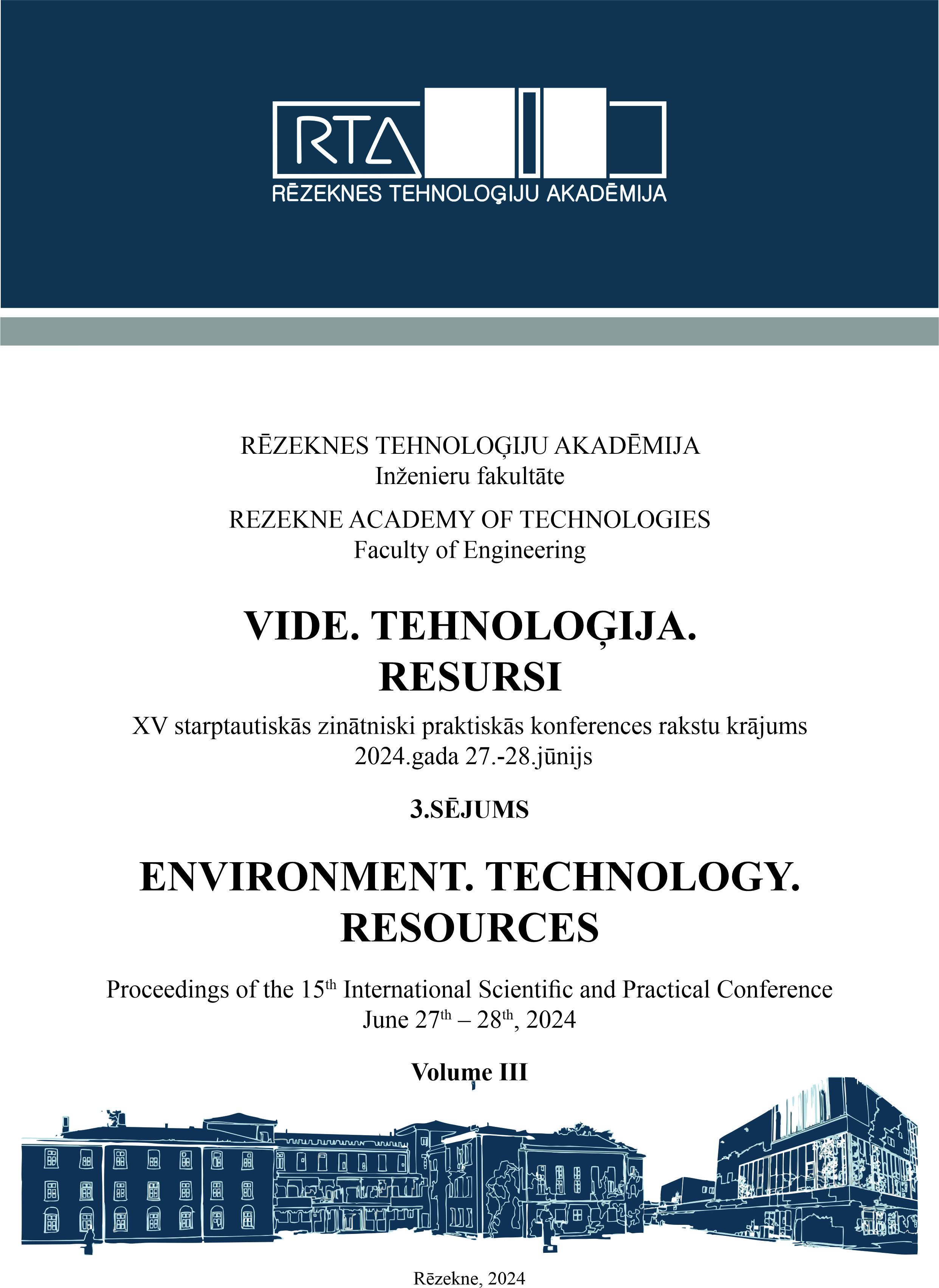INVESTIGATION OF LASER TEXTURING ON THE SURFACE OF ANODIZED ALUMINIUM
DOI:
https://doi.org/10.17770/etr2024vol3.8176Keywords:
nanosecond laser, laser texturing, fiber laser, roughness, wettabilityAbstract
This study examines the texturing of anodized aluminium using a Rofin PowerLine F 20 Varia nanosecond Yb doped fiber laser. It explores how varying laser parameters like scanning speed, hatching step, laser power, and frequency impact the surface's wetting properties, particularly the contact angle with a water droplet. The research aims to understand the influence of these parameters on the aluminium’s surface, offering insights into the laser micromachining process and its industrial and material science applications. This study examines the texturing of anodized aluminium using a Rofin PowerLine F 20 Varia nanosecond Yb doped fiber laser. It explores how varying laser parameters like scanning speed, hatching step, laser power, and frequency impact the surface's wetting properties, particularly the contact angle with a water droplet. The research aims to understand the influence of these parameters on the aluminium’s surface, offering insights into the laser micromachining process and its industrial and material science applications. This study investigates the texturing of anodized aluminium using a Rofin PowerLine F20 Varia nanosecond fiber laser. It investigates how different laser parameters such as scan speed, hatching step, laser power and frequency affect the surface wetting properties, especially the contact angle of a water droplet. The research aims to understand the influence of these parameters on the aluminium surface, offering insights into the laser micromachining process and its applications in industry and materials science.References
M. Gedvilas, B. Voisiat and G. Račiukaitis, “Grayscale Marking of Anodized Aluminium Plate by Using Picosecond Laser and Galvanometer Scanner”, Journal of Laser Micro/Nanoengineering, vol. 9, no. 3, p. 267-270, November 2014. [Abstract]. Available: ProQuest http://dx.doi.org/10.2961/jlmn.2014.03.0017 [Accessed February 5, 2024].
AAC, “What is Anodizing?”. [Online]. Available: https://www.anodizing.org/page/what-is-anodizing. [Accessed: February 5, 2024].
J. Penide, F. Quintero, A. Riveiro, A. Fernandez, J.del Val, R. Comesana, F. Lusquinos and J. Pou, “High contrast laser marking of alumina”, Applied Surface Science, vol. 336, p. 118-128, May 2015. [Abstract]. Available: ProQuest https://doi.org/10.1016/j.apsusc.2014.10.004 [Accessed February 5, 2024].
D. Zhemchuzhnikova, J. Zollinger, “Microstructure formation in 6061 aluminum alloy during nano-second pulsed laser processing’, Journal of Materials Processing Technology, vol. 314, May 2023. [Abstract]. Available: ProQuest https://doi.org/10.1016/j.jmatprotec.2023.117898 [Accessed February 15, 2024].
X. S. Li, W. P. He, L. Lei, J. Wang, G. F. Guo, T. Y. Zhang, T. Yue, “Laser direct marking applied to rasterizing miniature Data Matrix Code on aluminum alloy”, Optics Laser Technology, vol. 77, p. 31-39, March 2016. [Abstract]. Available: ProQuest https://doi.org/10.1016/j.optlastec.2015.08.020 [Accessed February 15, 2024].
D. Austin, L. Beagle, C. Muratore and N. R. Glavin, “Laser processing of nanomaterials: From controlling chemistry to manipulating structure at the atomic scale”, Hybrid Atomic-Scale Interface Design for Materials Functionality, p. 179-208, January 2021. [Abstract]. Available: ProQuest https://doi.org/10.1016/B978-0-12-819117-0.00008-5 [Accessed February 20, 2024].
J. Guo, X. Ma, Xiaolei, X. Si, Z. Yang, “Effect of Nanosecond Laser Treatment Parameters on Surface Wettability Behaviour of Pure Aluminium”, IOP Conference Series: Materials Science and Engineering, p. 538, June 2019. [Abstract]. Available: ProQuest https://iopscience.iop.org/article/10.1088/1757-899X/538/1/012021/pdf [Accessed February 22, 2024].
J. T. Cardoso, A. I. Aguilar-Morales, S. Alamri, D. Huerta-Murillo, F. Cordovilla, A. F. Lasagni, J. L. Ocana, “Superhydrophobicity on hierarchical periodic surface structures fabricated via direct laser writing and direct laser interference patterning on an aluminium alloy”, Optics and Lasers in Engineering, vol. 111, p. 193-200, December 2018, [Abstract]. Available: ProQuest https://doi.org/10.1016/j.optlaseng.2018.08.005 [Accessed February 22, 2024].
J. Zhao, J. Guo, P. Shrotriya, Y. Wang, Y. Han, Y. Dong, S. Yang, “A rapid one-step nanosecond laser process for fabrication of super-hydrophilic aluminum surface”, Optics Laser Technology, vol. 117, p. 134-141, September 2019. [Abstract]. Available: ProQuest https://doi.org/10.1016/j.optlastec.2019.04.015 [Accessed February 22, 2024].
Y. Cai, W. Chang, X. Luo, A. M. L. Sausa, K. H. A. Lau, Y. Qin, “Superhydrophobic structures on 316L stainless steel surfaces machined by nanosecond pulsed laser”, Precision Engineering, vol. 52, p. 266-275, April 2018. [Abstract]. Available: ProQuest https://doi.org/10.1016/j.precisioneng.2018.01.004 [Accessed February 23, 2024].
A. Pacejs, E. Yankov, I. Adijans., E. Terumnieks, L. Lazov, “Modification of Aluminum 1050 and 2219 Alloys Using CuBr Nanosecond Laser for Hydrophobic and Hydrophilic Properties”, Engineering Proceedings, vol. 56(1), p. 326, December 2023. [Abstract]. Available: ProQuest https://doi.org/10.3390/ASEC2023-16582 [Accessed February 23, 2024].
J. Drelich, E. Chibowski, D. D. Meng, K. Terpilowski, “Hydrophilic and superhydrophilic surfaces and materials”, Soft Matter, Issue 21, 2011. [Abstract]. Available: ProQuest https://doi.org/10.1039/C1SM05849E [Accessed February 24, 2024].
A. O. Ijaola, E. A. Bamidele, C. J. Akisin , I. T. Bello , A. T. Oyatobo, A. Abdulkareem, P. K. Farayibi, E. Asmatulu, “Wettability Transition for Laser Textured Surfaces: A Comprehensive. Surfaces and Interfaces”, vol. 21, December 2020. [Abstract]. Available: ProQuest https://doi.org/10.1016/j.surfin.2020.100802 [Accessed February 24, 2024].
L. Lazov, E. Teirumnieks, T. Karadzhov, N. Angelov, “Influence of power density and frequency of the process of laser marking of steel products”, Infrared Physics Technology, vol. 116, August 2021. [Abstract]. Available: ProQuest https://doi.org/10.1016/j.infrared.2021.103783 [Accessed February 25, 2024].
Indimart.com, “Powerline”. [Online]. Available: https://m.indiamart.com/proddetail/powerline-3593583130.html [Accessed: February 25, 2024].
Dino-Lite Europe, “AM7115MZT” https://www.dino-lite.eu/en/products/microscopes/universal/am7115mzt-edge [Accessed: February 25, 2024].
L. Denisova, A. Pacejs, E. Yankov, L. Lazov, “Analysing the influence of technological parameters on the process of laser marking of surface of anodised aluminium samples”, 2023, Proceedings of the 14th International Scientific and Practical Conference, vol. 3, p. 289-296.
Downloads
Published
Issue
Section
License
Copyright (c) 2024 Lubova Denisova, Antons Pacejs, Emil Yankov, Lyubomir Lazov

This work is licensed under a Creative Commons Attribution 4.0 International License.



